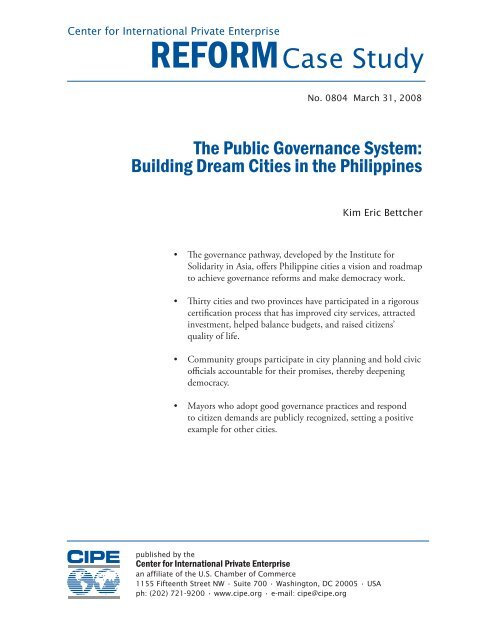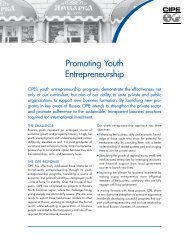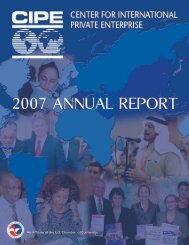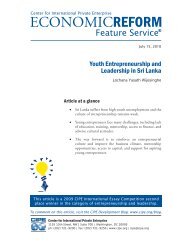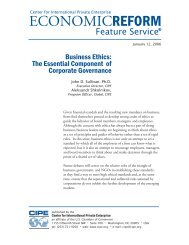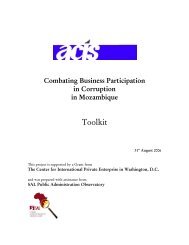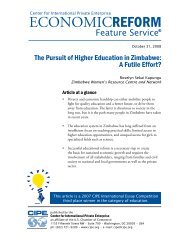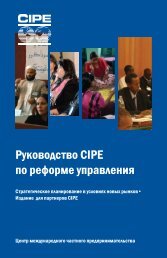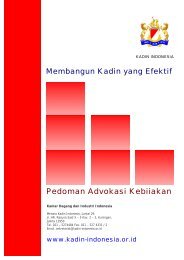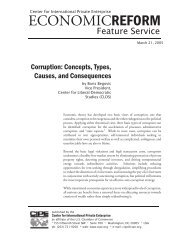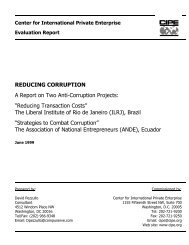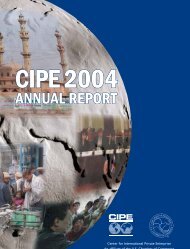The Public Governance System - Center for International Private ...
The Public Governance System - Center for International Private ...
The Public Governance System - Center for International Private ...
You also want an ePaper? Increase the reach of your titles
YUMPU automatically turns print PDFs into web optimized ePapers that Google loves.
<strong>Center</strong> <strong>for</strong> <strong>International</strong> <strong>Private</strong> EnterpriseREFORMCase StudyNo. 0804 March 31, 2008<strong>The</strong> <strong>Public</strong> <strong>Governance</strong> <strong>System</strong>:Building Dream Cities in the PhilippinesKim Eric Bettcher• <strong>The</strong> governance pathway, developed by the Institute <strong>for</strong>Solidarity in Asia, offers Philippine cities a vision and roadmapto achieve governance re<strong>for</strong>ms and make democracy work.• Thirty cities and two provinces have participated in a rigorouscertification process that has improved city services, attractedinvestment, helped balance budgets, and raised citizens’quality of life.• Community groups participate in city planning and hold civicofficials accountable <strong>for</strong> their promises, thereby deepeningdemocracy.• Mayors who adopt good governance practices and respondto citizen demands are publicly recognized, setting a positiveexample <strong>for</strong> other cities.published by the<strong>Center</strong> <strong>for</strong> <strong>International</strong> <strong>Private</strong> Enterprisean affiliate of the U.S. Chamber of Commerce1155 Fifteenth Street NW • Suite 700 • Washington, DC 20005 • USAph: (202) 721-9200 • www.cipe.org • e-mail: cipe@cipe.org
<strong>The</strong> <strong>Center</strong> <strong>for</strong> <strong>International</strong> <strong>Private</strong> Enterprise is a non-profit affiliate of the U.S. Chamber ofCommerce and one of the four core institutes of the National Endowment <strong>for</strong> Democracy.CIPE has supported more than 1,000 local initiatives in over 100 developing countries,involving the private sector in policy advocacy and institutional re<strong>for</strong>m, improvinggovernance, and building understanding of market-based democratic systems. CIPEprovides management assistance, practical experience, and financial support to localorganizations to strengthen their capacity to implement democratic and economicre<strong>for</strong>ms. CIPE programs are also supported through the United States Agency <strong>for</strong><strong>International</strong> Development.<strong>The</strong> National Endowment <strong>for</strong> Democracy (NED) is a private, non-profit organization createdin 1983 to strengthen democratic institutions around the world through nongovernmentalef<strong>for</strong>ts. <strong>The</strong> Endowment is governed by an independent, non-partisan board of directors.With its annual congressional appropriation, it makes hundreds of grants each year tosupport prodemocracy groups in Africa, Asia, Central and Eastern Europe, Latin America,the Middle East, and the <strong>for</strong>mer Soviet Union.<strong>The</strong> Institute <strong>for</strong> Solidarity in Asia (ISA) was established in 2000 to mobilize the businesssector and civil society of the Philippines toward contributing substantively to alleviatingpoverty, improving the business climate, and promoting responsible citizenship. ISAworks with government, business, and civil society at the local level to turn strategy andgoals into real improvements in governance, resulting in positive outcomes <strong>for</strong> citizens.For more in<strong>for</strong>mation, contact:<strong>Center</strong> <strong>for</strong> <strong>International</strong> <strong>Private</strong> Enterprise1155 Fifteenth Street NW • Suite 700Washington, DC 20005USAph: (202) 721-9200 • fax (202) 721-9250www.cipe.org • e-mail: cipe@cipe.orgCIPE’s support of the Institute <strong>for</strong> Solidarity in Asia wasfunded by the National Endowment <strong>for</strong> Democracy.
Building Dream Cities in the Philippines<strong>Center</strong> <strong>for</strong> <strong>International</strong> <strong>Private</strong> EnterpriseIntroductionOn August 30, 2007, the mayors of three Philippinecities proudly reported to the third <strong>Public</strong> <strong>Governance</strong>Forum on some remarkable changes occurring in theircities of Marikina, San Fernando, and Tagbilaran. <strong>The</strong>secities are becoming more competitive, more livable,and more responsive to the aspirations of their citizens.<strong>The</strong> changes in each city are the product of a commonvision – a vision developed through consultation andrealized through sound planning methods.Other mayors and municipal officials had come tolearn about good governance practices at this <strong>for</strong>umhosted by the Institute <strong>for</strong> Solidarity in Asia (ISA),a partner of the <strong>Center</strong> <strong>for</strong> <strong>International</strong> <strong>Private</strong>Enterprise (CIPE). <strong>The</strong>y took classes in ISA’s <strong>Public</strong><strong>Governance</strong> <strong>System</strong> and exchanged experiences at aLearning Institute. In all, 24 mayors have signed onto ISA’s governance system, and interest continuesto grow at the municipal, provincial, and nationallevels. Even the Philippine Military Academy and thenursing profession have embraced ISA’s approach tobetter governance.What explains this wide interest in governancepractices? ISA’s program addresses a deeply feltneed in the Philippines <strong>for</strong> greater professionalismand integrity in public life in order to undertakedevelopmental challenges and serve the people.<strong>The</strong> program’s popularity stems from the clearpath it provides through a morass of complexity,Mayor Mary Jane Ortega (left) gives out a plaque of recognition toMayor Dan N. Lim with Atty. Nuevas Montes of Tagbilaran City.City of San Fernando, PampangaAchievements<strong>The</strong> City of San Fernando, Pampanga hasliterally risen from the ashes of the 1991 eruptionof Mount Pinatubo. From December 2005 toJanuary 2006, with ISA’s assistance, the citycrafted a roadmap, set well-defined targets, andgathered community input and support <strong>for</strong> itsvision.• 135 million pesos directed to new schoolbuildings will benefit 126,000 students in 35districts over the next 10 years.• A one-stop shop <strong>for</strong> processing businesspermits, taxes, and fees has cut the timeneeded to obtain documents.• <strong>The</strong> number of small- and medium-sizedenterprises registered with city hall hasjumped to 6,700 from 5,700 a year ago.• Big companies are investing in San Fernando,such as Avida Land Corp., Landco PacificCorp., and TeleTech Holdings, Inc.corruption, and division to arrive at practical,sustainable solutions. <strong>The</strong> governance pathway offersparticipating institutions a sequence of constructivesteps and incentives to achieve re<strong>for</strong>m goals and makedemocracy work.<strong>The</strong> Philippines’ ChallengeISA’s initiative is trans<strong>for</strong>ming the Philippines stepby step <strong>for</strong> the benefit of its citizens, and in the processis overcoming corruption and apathy. Since the initialvictory in 1986 of “people power,” the Philippines hasstruggled to establish a democracy capable of addressingthe needs of all levels of society. Incessant turmoilin national politics has shaken public confidence ingoverning institutions and impeded improvements inthe quality of life.<strong>The</strong> political turmoil has created a “tendency tofocus on personalities rather than on institutions;to focus on the short term, rather than on the longterm; to focus on tactics, rather than on strategy…” 1To overcome these political hurdles, along witheconomic and other developmental hurdles, ISA haslabored to increase citizen participation and improvethe transparency and efficiency of government. In the– 1 –
<strong>Center</strong> <strong>for</strong> <strong>International</strong> <strong>Private</strong> Enterprise<strong>The</strong> <strong>Public</strong> <strong>Governance</strong> <strong>System</strong>words of Dr. Jesus P. Estanislao, founding chairman ofISA, “good governance is an oft-repeated aspiration;it is as though it were the silver lining in the darkclouds that almost permanently hover over our skies.<strong>The</strong> challenge is clear – develop good governancemechanisms in a democracy with weak nationalgovernance institutions.” 2ISA describes governance as a partnership betweenthe governors and the governed. In ISA’s view,ordinary citizens must play a participatory role toensure effective governance. At the same time, thereis a need <strong>for</strong> a system to translate the visions andaspirations of responsible citizens, community leaders,and public officials into measurable commitmentsand initiatives.A National RoadmapCity of Marikina AchievementsMarikina’s move to position itself as abusiness-friendly city has paid off with 20 billionpesos ($483.8 million) in new investments in2006-2007. Marikina also managed to open ayouth employment center and launch a clean aircampaign while balancing its 2006 budget.• 7,000 people were empowered to make alivelihood through job skills training.• 15 public parks were developed and 6,000trees were planted in 2007.For hope to be translated into reality, there mustbe practical measures that lead towards a focused goal.“<strong>The</strong> thinking has to be big and bold. But the actinghas to be done in small and sustained steps.” 4 With itsoverarching vision in hand, ISA looked <strong>for</strong> places tobegin re<strong>for</strong>m from the bottom up.Dr. Estanislao has a history of foundingand rehabilitating institutions. He is known <strong>for</strong>rehabilitating the Development Bank of the Philippinesand founding the University of Asia and the Pacific, aswell as the Institute of Corporate Directors. A <strong>for</strong>merSecretary of Finance inPresident Aquino’s cabinet,he and other leaders fromvarious sectors of Philippinesociety decided in 2001 totake action in shaping theinstitutional future of thecountry. Although ISAstarted conceptualizing the“<strong>The</strong> thinking has tobe big and bold. Butthe acting has to bedone in small andsustained steps.”– Dr. Jesus Estanislao,ISA Chairman<strong>Public</strong> <strong>Governance</strong> <strong>System</strong> early on in the process, itsfirst task was to gather citizen groups to chart out abroad vision and direction <strong>for</strong> the Philippines.Together, they created the “Philippines 2030Roadmap” to instill shared values, a sense of community,and the hope <strong>for</strong> prosperity and progress. <strong>The</strong> Roadmapgot citizens thinking about a common cause and theinterdependence of all elements of society. “Insteadof allowing ourselves to be immobilized by despair,we should work together as responsible citizens andfoster hope,” urged Dr. Estanislao. “Instead of gettingdrowned by a multitude of seemingly unrelated andintractable issues, we use the inter-connection betweenissues in order to address them systematically.” 3– 2 –Planning Dream CitiesRather than throwing up its hands at the obstaclesto re<strong>for</strong>ming national government, ISA identifiedpromising localities and sectors in which to nurturepockets of good governance, involve citizens, andcreate anchors <strong>for</strong> future results. Citizens were usuallymore actively involved in the decision-making processat the local level compared to the national level. “Noteverything in politics is done in Manila, so there’s a lotthat is very positive that is being done outside Manila,”explained Dr. Estanislao. 5ISA decided to target municipal governancebecause of the increasing strategic importance of citiesin the Philippines. More than half of the Philippinepopulation lived in 116 cities scattered across thecountry. Urban centers accounted <strong>for</strong> 70 percent ofgross domestic product, yet many cities still had notreached their economic potential due to unfocusedplanning. In 1991, the new Local GovernmentCode gave cities a larger role in public governance.ISA’s program built on citizen involvement to givesubstance to local governance and administrativedecentralization.
Building Dream Cities in the Philippines<strong>Center</strong> <strong>for</strong> <strong>International</strong> <strong>Private</strong> EnterpriseCity of Marikina RoadmapVISION:A Model City in Competitiveness in Southeast Asia by 2015Quality of Life Good <strong>Governance</strong> Financial StabilitySocial services &security at par withbest in the region• 1 family, 1 house• Service satisfactionindex = 4.5MISSIONTo sustain the city’sdevelopmental ef<strong>for</strong>tsand harness itspotentials <strong>for</strong> higherstandards of growth <strong>for</strong>the benefit of the entirecountry.Best in quality of life•70% reduction inpoverty incidenceDelivery of servicesto stakeholders• 100% customersatisfactionA model <strong>for</strong> good<strong>Governance</strong>• In the top 5 in allaspects of the citycompetitive indexInfrastructure• Travel time 2x faster• At par with best cities inSoutheast Asia• Accessibility of 100% of populationto communication technologyClean and Green Environment• Full compliance with environment laws• Citywide greening 1 tree : 4 persons• Cleanliness (air, land & water quality)at par with national & internationalstandardsFinancial growth &Stability• Ph 5B in revenuesBusiness Friendly• 3-fold increase in thenumber of enterprisesGlobally Competitive• Preferred venue <strong>for</strong>international eventsAttitude of citizenry• Zero unrestCommunity Participation• Community programs 100%organized and managedby private sectorCapability building <strong>System</strong>• literacy rate & productivityat par with top cities• 1 family at least 2 jobsCore ValuesDiscipline * Good <strong>Governance</strong> * Pursuit of Excellence * Moral Uprightness * Love of GodEight cities stepped <strong>for</strong>ward to become pioneersin the ISA <strong>Public</strong> <strong>Governance</strong> <strong>System</strong>. Each crafted avision of what their community would be in the year2015, together with a roadmap of how to achieve thevision and scorecards to measure progress. Marikina isan excellent example.City of MarikinaVisionTo become “a model city in competitiveness” by2015.Mission“To sustain the city’s developmental ef<strong>for</strong>ts andharness its potential <strong>for</strong> higher standards of growth<strong>for</strong> the benefit of the entire country.”<strong>The</strong> City of Marikina, working side by side with amulti-sectoral civic coalition, set 12 primary objectives<strong>for</strong> the city as well as high standards of achievement.Marikina mapped out a series of mutually supportiverelationships among these objectives, which it groupedaccording to developmental, financial, organizational,and constituent priorities. Beginning with citizenempowerment andcommunity participation,the roadmap indicatedhow good governancewould sustain a businessfriendlyenvironment andultimately make Marikina acompetitive city enjoying ahigh quality of life.Thanks to thePGS, “the ordinarycan becomeextraordinarilyeffective.”– Mayor Oscar M.Rodriguez, SanFernando, Pampanga– 3 –
<strong>Center</strong> <strong>for</strong> <strong>International</strong> <strong>Private</strong> Enterprise<strong>The</strong> <strong>Public</strong> <strong>Governance</strong> <strong>System</strong>Scorecard <strong>for</strong> the Business Sector in the City of MarikinaOBJECTIVESBest in quality of life in Southeast AsiaSocial Services and SecurityBusiness FriendlyClean and Green EnvironmentMost Efficient Delivery of Basic Servicesin Southeast AsiaGlobally CompetitiveMost Efficient Capability Building <strong>System</strong>in Southeast AsiaMost Active Community ParticipationBest Attitude of CitizenryMost Efficient Infrastructure inSoutheast AsiaMEASURESBusiness belong to the sunrise industry50% of workers living in the city areemployedMulti-awarded business chamber50% decrease in garbage collectionCustomer satisfaction and delightat par with Southeast Asia’s notableindustries/businessesExcellent craftsmen & craftsmanship/servicesModel curriculum in labor and businesseducation40% of annual target visitors areinterested in business tourism- Multi-awarded business organization- Several entrepreneurs and industriesare consistently recognizedby international businessorganizations- Compliance w/ Global CompactInitiative of U.N.Road, IT, and telecom infrastructuresare all in placeTARGETS 2015360 percent growth in profitabilityOne person per household is employedin any medium- to large-scale businesswithin the cityHall of Fame in Southeast Asia’s BestBusiness OrganizationAll business establishments implementindividual or communal wastemanagement program specifically theestablishment of Material RecoveryFacility (MRF)100 percent: Zero complaint/Zeroreturn of goodsAll leading products/ services have theseal of excellence/ ISO certifiedFully functioning Labor Market andLifestyle Village.Leader in business tourism5 percent of local business is in the top1,000 corporations of Southeast Asia<strong>The</strong> region’s best businessinfrastructureThis scorecard <strong>for</strong> business, one of several scorecards <strong>for</strong> Marikina’s sectors, shows the measures and targets by which:• Business will support top objectives on the city’s roadmap• Citizens will benefit from business development and business contributions to the city• Business will benefit from improved local governance<strong>The</strong> <strong>Public</strong> <strong>Governance</strong> <strong>System</strong> 6At the core of the Dream Cities program is ISA’s<strong>Public</strong> <strong>Governance</strong> <strong>System</strong> (PGS). ISA developedthe PGS based on the Balanced Scorecard, a strategicplanning and management system originated atHarvard Business School. A Balanced Scorecardtranslates strategy into concrete measures thatcommunicate a vision to an organization. <strong>The</strong>approach has been widely implemented in the privatesector and has also been extended <strong>for</strong> use in the publicsector, by, <strong>for</strong> example, a number of cities across theUnited States. CIPE arranged <strong>for</strong> a delegation ofPhilippine mayors to visit cities such as Charlotte,North Carolina, and Austin, Texas, to observehow these cities have successfully implementedthe Balanced Scorecard to improve municipalper<strong>for</strong>mance.<strong>The</strong> PGS process, as adapted by ISA <strong>for</strong> Philippinecities, contains a vital innovation: the communitybecomes a co-owner of the plan with the city. ISA’s– 4 –
<strong>Center</strong> <strong>for</strong> <strong>International</strong> <strong>Private</strong> Enterprise<strong>The</strong> <strong>Public</strong> <strong>Governance</strong> <strong>System</strong>become extraordinarily effective,” declared MayorOscar M. Rodriguez of San Fernando.ISA has clarified the steps to be taken as part of thegovernance re<strong>for</strong>m process through its “governancepathway.” <strong>The</strong> pathway offers practical guidance onmeasures toward institutionalizing good governance,and lays out a common standard <strong>for</strong> evaluatinghow cities and communities are developing in theirgovernance re<strong>for</strong>m. For instance, a city that has reachedthe “proficient” stage on the pathway is recognized byISA to have per<strong>for</strong>med rigorous strategic planningusing scorecards, aligned its organization and resourceswith the strategy, and implemented a mechanism toreport on its per<strong>for</strong>mance.Reporting Back:<strong>The</strong> <strong>Public</strong> <strong>Governance</strong> ForumTransparency sustains the governance process inmultiple ways. ISA’s semi-annual <strong>Public</strong> <strong>Governance</strong>Forum combines multiple features of governancere<strong>for</strong>m in a credible, transparent venue. At the <strong>for</strong>um,city leaders who have reached given milestones on thegovernance pathway address their peers – and a wideraudience through the media – on the status of theirre<strong>for</strong>m ef<strong>for</strong>ts. Leaders of civic associations and certainpublic institutions likewise participate. In this manner,the <strong>for</strong>um per<strong>for</strong>ms the following functions:• Mayors and civic leaders publicly pledge toadopt a discipline of democratic governance inthe pursuit of city objectives, thereby tying theirreputations to governance re<strong>for</strong>m.• Citizens and stakeholder groups are keptin<strong>for</strong>med about issues of concern and measuresthat local governments are taking to addressthem.• Through the uni<strong>for</strong>m reporting framework,citizens and stakeholder groups can checkwhether previous commitments have beenhonored and can hold their officials accountable.• Mayors who are reporting on progress receiverecognition <strong>for</strong> positive changes they have made.– 6 –• Participants in governance re<strong>for</strong>m ef<strong>for</strong>ts providemutual support and assume joint ownership ofthe endeavor.• New and experienced leaders alike learn fromothers’ experiences and practices, especially at theLearning Institute hosted in conjunction with the<strong>for</strong>um.Under the banner “Mahal Ko Ang Pilipinas” (“Ilove the Philippines”), the <strong>for</strong>um highlights publicservice success stories and responsible citizenship toovercome cynicism and demonstrate that there is a way<strong>for</strong>ward. Regularly attendedby about 20 mayors as wellas leaders from PGS anchorgroups, civic groups, andbusiness, the <strong>for</strong>um spreadsa message of hope andgood governance throughsubstantial national mediacoverage.Results So FarAs of the end of 2006, 24cities had already adoptedthe <strong>Public</strong> <strong>Governance</strong>CIPE arranged <strong>for</strong>a delegation ofPhilippine mayorsto visit cities suchas Charlotte, NorthCarolina, and Austin,Texas, to observehow these citieshave successfullyimplemented theBalanced Scorecardto improve municipalper<strong>for</strong>mance.<strong>System</strong>. Mayors and sector leaders of several morecities had committed to institutionalizing the system.New mayors are regularly recruited by current fellowsof the program.<strong>The</strong> business environment was improving amongthe cities farthest along the pathway. <strong>The</strong> NationalCompetitiveness Council declared eight of the DreamCities to be “business friendly.” 7 Marikina brought in20 billion pesos in new investments in 2006-2007,and San Fernando (Pampanga) had 481 million pesos<strong>for</strong> the same timeframe.In May 2007, out of 20 mayors standing <strong>for</strong> reelectionwith whom ISA was working, 18 were reelected(or the candidate they endorsed). This indicatesthe strong incentives <strong>for</strong> these and other mayors topursue a better governance standard. It also suggeststhat voters were pleased with the PGS approach – or,more likely, its early results.
Building Dream Cities in the Philippines<strong>Center</strong> <strong>for</strong> <strong>International</strong> <strong>Private</strong> EnterpriseISA has initiated a program to extend goodgovernance outreach through a new network known asCLEAN, which stands <strong>for</strong> the <strong>Center</strong>s <strong>for</strong> Leadershipin East Asia Network. CLEAN Philippines has sixfounding members: ISA, the Institute of CorporateDirectors, the Philippine Military Academy, and thecities of Marikina, San Fernando (Pampanga), andTagbilaran.Strengths of the PGS Model andLessons Learned<strong>The</strong> purposes of the <strong>Public</strong> <strong>Governance</strong>e <strong>System</strong>include not only strategic planning, but also practicalimplementation, citizen participation, and governmentaccountability. <strong>The</strong> <strong>Public</strong> <strong>Governance</strong> <strong>System</strong>, asa Philippine adaptation of the Balanced Scorecard,has proven to be an effective and popular strategicplanning tool in Philippine cities at different levelsof development and located in diverse areas of thecountry. <strong>The</strong> system may serve well in other countries,as well, with appropriate adjustments to local needs.Civil society must play a leadership role.One of the greatest strengths of the publicgovernance system is the participation of representativesfrom all major segments of civil society. Citizens takepart in setting objectives and per<strong>for</strong>mance measures<strong>for</strong> governing institutions as well as <strong>for</strong> themselves.Following through onthe planning, civil societygroups make their share ofcontributions to the resultsand hold governmentaccountable <strong>for</strong> reachingcollective goals.One of the greateststrengths of the publicgovernance system isthe participation ofrepresentatives fromall major segments ofcivil society.When facilitatingcoalitions of civic groups,ISA found it necessary to have an “anchor group” ineach social sector. <strong>The</strong> anchor group takes ownershipand provides structure to the coalition. While it is best<strong>for</strong> a coalition to be inclusive and broadly representative,the anchor group serves as the organizational core.Create political incentives.Another reason why the governance pathwayworks so effectively is that it combines administrativeprofessionalism with political incentives. Mayors andinstitutions that reach ISA’s milestones – and that passaudits by ISA and their peers – are duly recognized<strong>for</strong> their achievements. <strong>The</strong> PGS reveals the goodactions that have been taken, and encourages futureconstructive action. ISA has built a foundation byworking with some of the best local leaders – thosewho are serious about governance discipline – at thesame time as inviting and challenging other leaders tofollow this route to competitiveness.Focus on specific communities or institutions.ISA has publicly committed to fostering anationwide governance re<strong>for</strong>m movement. Withthat clear goal, ISA has begun strategically workingin selected communities and organizations thatare motivated and ready to embrace change. Eachcommunity establishes its own specific set of objectives,then brings the combined <strong>for</strong>ces of the community tobear on priority tasks. In other words, a comprehensiveapproach to re<strong>for</strong>m with a relatively narrow focus isthe best methodology._________________________________________NotesCity of Tagbilaran AchievementsOnce in the shadow of communist insurgency,this city is building its future as an eco-tourismand cultural hub. It has broken ground <strong>for</strong> a singlewindow office to simplify transactions <strong>for</strong> landadministration, and has delivered free hospitalbenefits to the poor. Tagbilaran topped the AsianInstitute of Management’s quality of life survey,announced in February 2006, <strong>for</strong> cities with up to200,000 people.1Jesus P. Estanislao, “A <strong>Governance</strong> <strong>System</strong> <strong>for</strong> the Philippines,”presented at the Global <strong>Public</strong> Sector Summit hosted by theBalanced Scorecard Collaborative, Washington, D.C. (October10, 2007).2Jesus P. Estanislao, “Strengthening Democracy in thePhilippines: Civil Society Solutions to <strong>Public</strong> <strong>Governance</strong>,”Economic Re<strong>for</strong>m Feature Service (December 15, 2005).– 7 –
<strong>Center</strong> <strong>for</strong> <strong>International</strong> <strong>Private</strong> Enterprise<strong>The</strong> <strong>Public</strong> <strong>Governance</strong> <strong>System</strong>3Jesus P. Estanislao, Philippines 2030, Journey to Nationhood:Towards a National Community of Responsible Citizens, MakatiCity, Philippines: Institute <strong>for</strong> Solidarity in Asia (2006). p. x.4Estanislao, Philippines 2030, p. 84.5Jesus P. Estanislao as quoted in Philippine Daily Inquirer, “8Cities Shine Amid Gloom of RP Politics” (11 August 2005).6<strong>The</strong> description of the <strong>Public</strong> <strong>Governance</strong> <strong>System</strong> draws upona presentation by Nick B. Fontanilla at an orientation <strong>for</strong> civicofficials on August 29, 2007.7Ronnel W. Domingo, “8 Cities Cited <strong>for</strong> Being ‘BusinessFriendly,’” Philippine Daily Inquirer (October 31, 2007): B1–2.SourcesJesus P. Estanislao, Philippines 2030, Journey to Nationhood:Towards a National Community of Responsible Citizens,Makati City, Philippines: Institute <strong>for</strong> Solidarity in Asia(2006).Jesus P. Estanislao, “Strengthening Democracy in thePhilippines: Civil Society Solutions to <strong>Public</strong> <strong>Governance</strong>,”Economic Re<strong>for</strong>m Feature Service (December 15, 2005).Evelyn R. Singson, “Business Vision <strong>for</strong> the Future of thePhilippines,” Economic Re<strong>for</strong>m Feature Service (September19, 2006).– 8 –


